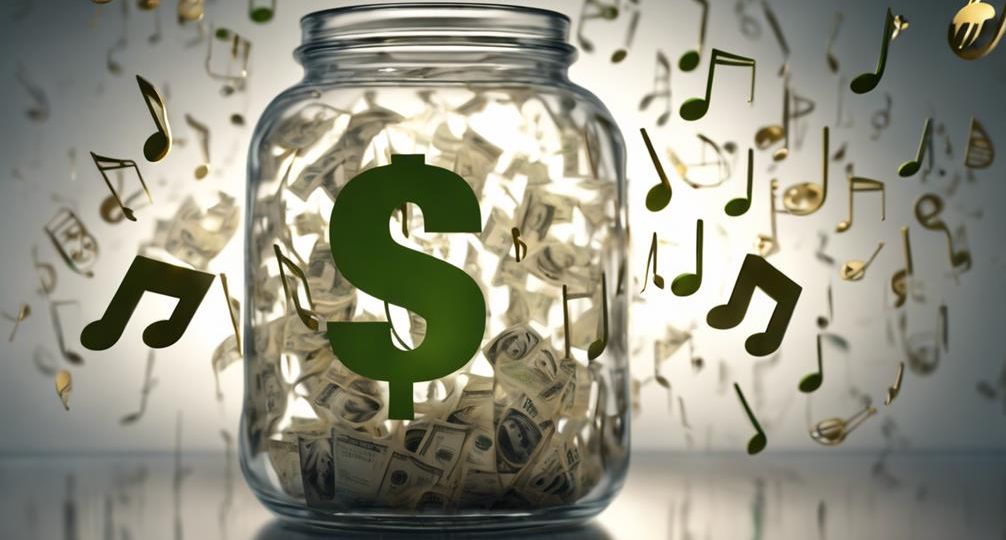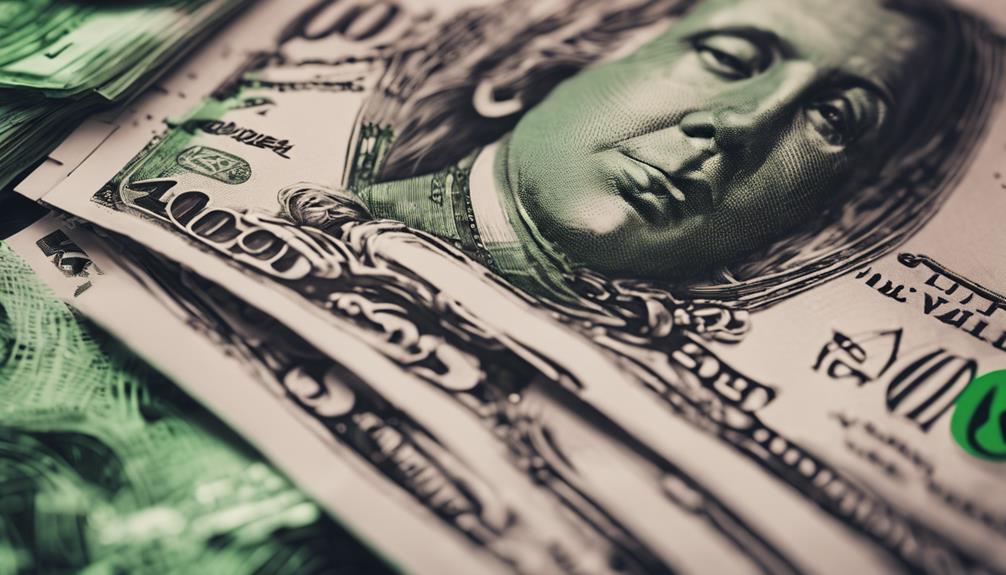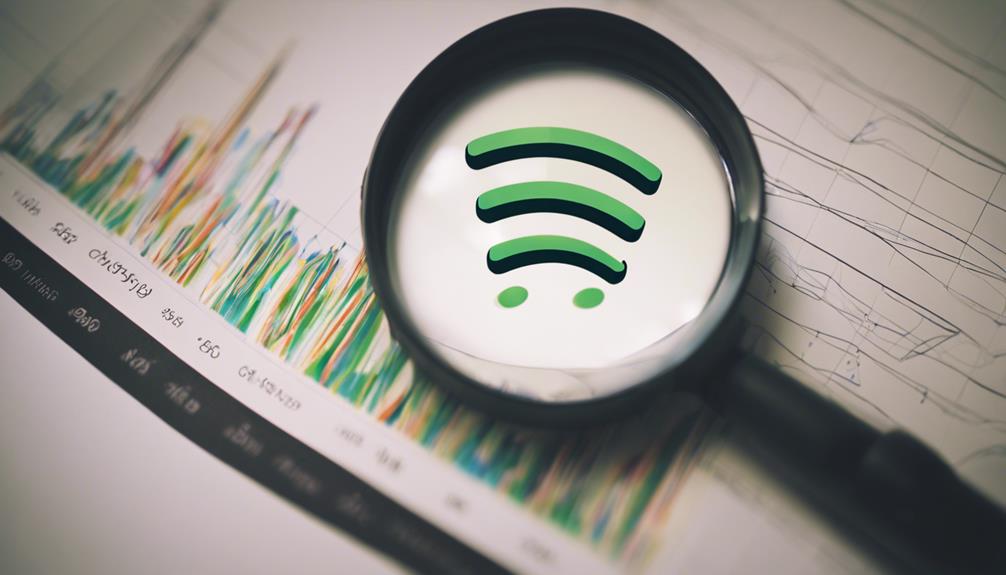
How many plays on Spotify does it take to make $100?
Based on Spotify’s average per-stream payout rate, you’d need around 25,000 to 33,000 plays to earn $100. This amount varies with factors such as listener location and subscription type. Premium users generate higher royalties than free users. It’s worth noting that strategies like optimizing playlist titles and engaging with fans can help increase your number of plays. Delving deeper into Spotify’s payment structure and streaming’s role in music industry revenue could lead to a better understanding of how to maximize your earnings through the platform.
Key Takeaways
- Spotify pays artists a fraction of a penny per stream, with average rates between $0.003 and $0.005 per stream.
- To make $100, artists would need approximately 20,000 to 33,333 streams, based on the average payout rate.
- Payouts can vary based on factors such as listener location and subscription type (free or premium).
- Maximizing earnings requires strategies like playlist optimization, fan engagement, and understanding Spotify’s algorithms.
- Changes in Spotify’s payment structure or competition may affect future earnings per stream.
Understanding Spotify’s Business Model

In order to understand how much you can earn from Spotify, it’s important to first grasp its unique business model that revolves around a blend of advertisement-supported and premium subscription services. Spotify’s ad-supported listening option allows users to stream music for free, but with occasional breaks for advertisements. Revenue from these ads is then distributed amongst rights holders based on their share of total streams.
However, the real value proposition lies in Spotify’s subscription benefits. Premium users, who pay a monthly fee, enjoy uninterrupted, ad-free listening alongside the ability to download music for offline use. This premium model not only provides a superior user experience but also significantly boosts Spotify’s revenue. In fact, the majority of Spotify’s income is derived from these subscriptions, providing a larger pool of funds to distribute to artists and rights holders.
Understanding this dual revenue model is the key to gauging your potential earnings on Spotify. While ad-supported listening provides some income, it’s the premium subscriptions that’ll significantly inflate your paycheck. It’s an innovative business model that aligns the interests of Spotify, its users, and artists, creating a win-win-win situation.
The Role of Streaming in Music Revenue
You might think that streaming is just another way to enjoy music, but it’s a lot more than that. It’s changed the way musicians earn money and has a direct impact on their overall earnings.
To better understand this, we’ll look at how Spotify’s payment model works and how it affects revenue from music.
Streamings Impact on Earnings
Over the past decade, streaming has drastically reshaped the music industry’s revenue landscape, becoming a crucial player in an artist’s earnings. The advent of streaming technology has ushered in a new era of revenue diversification, allowing musicians to tap into a previously untapped reservoir of income generation.
Streaming platforms, like Spotify, have become the go-to mediums for music consumption, driving a significant portion of an artist’s income. In the past, artists relied heavily on album sales and live performances for their earnings. Now, every play on a streaming platform translates into revenue.
However, it’s not just the quantity of streams that matter. The importance, or rather the geographical location and subscription type of listeners, also plays a significant role in determining these earnings. Higher-tier subscription listeners and those located in certain regions contribute more to an artist’s earnings per stream, creating a complex web of factors that musicians must navigate to maximize their income.
Streaming’s impact on earnings is undeniable, offering artists a steady stream of income, albeit smaller per unit, but potentially greater in volume. It’s a game-changer, offering a new model of music consumption and revenue generation, pushing the music industry into a fresh chapter of innovation and opportunity.
Understanding Spotifys Payment Model
To fully understand the role of streaming in music revenue, it’s important to explore Spotify’s unique payment model. Unlike traditional revenue streams, Spotify’s model is based on a variety of factors, not just the number of plays.
Royalties: Spotify pays a fraction of a penny for each stream. This rate varies but is notably lower than Spotify’s competitors like Apple Music and Tidal.
Market Share: The total number of streams on Spotify affects the royalty rate. The more popular the artist, the higher the percentage of Spotify’s revenue they receive.
User Subscription Type: Free users generate less revenue than premium subscribers. The type of listener affects the payout.
Playlist Curation: Being featured on popular playlists can skyrocket an artist’s streams and subsequent earnings.
Therefore, though difficult to pinpoint exactly how many streams equate to $100, understanding Spotify’s multi-layered payment model gives you a clearer picture. While the model is innovative and adapts to the digital age, it also presents new challenges to artists accustomed to traditional revenue streams.
As the music industry evolves, understanding such models becomes even more important.
How Spotify Calculates Artist Payments

Understanding how Spotify calculates artist payments is essential to your grasp of earning potential on the platform.
Spotify’s payment model, a complex algorithm involving multiple factors, directly impacts an artist’s earnings.
As we explore this model, we’ll shed light on the intricate dynamics of streaming payouts and how they translate into real dollars for artists.
Spotify’s Payment Model
Diving into Spotify’s payment model, you’ll find it’s not as straightforward as earning a set amount per play. Rather, it’s influenced by various factors, all contributing to how much an artist can make.
Subscriber Listening Time: The time Spotify Premium users spend listening to a particular artist, compared to the total listening time of all users, contributes to the payment calculation.
Advertisements Impact: For non-premium users, the revenue from ads also plays a notable role in determining the payout. More plays mean more ad impressions, which in turn translates into more revenue.
Market Share: The geographical location of listeners also affects the payout. For example, streams from higher-income countries tend to generate more revenue.
Artist’s Royalty Rate: This is determined by the artist’s agreement with their record label and can have a significant impact on earnings.
Understanding these factors can help demystify Spotify’s complex payment structure. With this knowledge, you’re better equipped to navigate the digital music landscape, whether as an artist or a devoted listener.
While the model might seem challenging, it’s a reflection of Spotify’s commitment to adapt and innovate in the evolving music industry.
Impact on Artists’ Earnings
Now that you’re familiar with Spotify’s payment model, let’s explore how these factors directly influence an artist’s earnings and break down the process of how Spotify calculates artist payments. While it’s tempting to assume that all you need for hefty earnings is a hit song, there’s more intricacy at play.
Spotify’s payout system is based on the proportion of total streams an artist garners. This means that your earnings as an artist are dependent on your popularity compared to others on the platform. It’s a dynamic ecosystem where the total payout pool and the number of total streams constantly fluctuate, affecting artists’ income.
But here’s where artist promotion comes into play. The promotion of your music on Spotify can greatly increase your share of total streams, thereby boosting your earnings. With effective promotion strategies, you can increase your visibility, attract more listeners, and ultimately drive up your Spotify revenue.
However, solely relying on Spotify streams for income isn’t a wise move. Revenue diversification is important. Consider other income streams like live performances, merchandise sales, or even Patreon support. This way, even if your Spotify earnings fluctuate, you have other financial safety nets in place.
The Impact of Spotify’s Royalty Rate
The royalty rate set by Spotify greatly impacts how many plays an artist needs to generate $100, making it an important aspect to grasp for those looking to earn from the platform. This rate, often shrouded in royalty controversies, is influenced by various elements including subscription pricing.
Now, let’s break down the impact of Spotify’s royalty rate:
- Subscription Pricing: Spotify’s royalty payouts vary depending on the listener’s subscription type. Premium subscribers contribute more to the artist’s earnings than free users.
- Royalty Controversies: Critics argue that Spotify’s royalty rate is too low, making it difficult for artists, especially emerging ones, to earn a fair income.
- Earnings Distribution: The total royalty pool is divided among all streamed tracks. Therefore, the more popular a track, the greater share of royalties it receives.
- Market Differences: Royalty payouts also vary by region due to differences in advertising rates and subscription pricing.
Understanding these aspects can help you strategize and maximize your potential earnings on Spotify. Remember, innovation isn’t just about creating music; it’s about understanding the business side of things too.
Factors Influencing Spotify Payouts

Beyond the influence of Spotify’s royalty rate, several other factors come into play when determining your potential earnings on the platform. One such factor is Spotify censorship. If Spotify decides that your content violates their content policy, they may remove your work, thereby affecting your potential plays and earnings. It’s important, therefore, to thoroughly understand and adhere to their guidelines to make sure your music isn’t subject to removal.
Regional disparities also greatly influence Spotify payouts. The platform calculates royalties based on where your listeners are located. If your audience mainly resides in regions with lower subscription prices and ad rates, you’ll earn less per stream. Conversely, more affluent regions with higher subscription prices yield better payouts. This highlights the importance of considering your target audience’s geographic distribution when strategizing your music promotion.
Furthermore, the amount of premium users who listen to your music also impacts your earnings. Premium users generate higher royalties than free users, so attracting a premium audience can help boost your revenue.
Case Study: Spotify Streaming Numbers
Frequently, diving into real-world examples provides a clearer picture of how Spotify streaming numbers truly translate into earnings. Streaming algorithms and artist promotion play significant roles in this dynamic.
Let’s consider an artist who receives about 500,000 monthly streams on Spotify. Such numbers would translate to an approximate income of $2,000 – $2,500 per month. Yet, it’s not as straightforward as it seems. There are several considerations to make:
- The country where the majority of the streams originate from. The royalty rates differ across regions.
- Spotify’s payout is generally higher for Premium users’ streams compared to those of Free-tier listeners.
- The overall popularity of the artist and their tracks. More popular tracks get more plays, which increases earnings.
- The organic versus paid promotion ratio. A higher percentage of organically achieved listens can lead to more consistent long-term earnings.
Understanding these factors allows you to grasp how Spotify’s streaming algorithms function.
While the numbers may seem challenging, remember that the music streaming industry is still relatively young and continuously evolving. Harnessing its potential requires a blend of creativity, strategy, and knowledge.
Maximizing Earnings on Spotify

Now that you’ve got a grasp on how Spotify streaming numbers translate into earnings, let’s explore strategies to maximize those earnings on the platform.
First and foremost, playlist strategies are key. Craft playlist titles and descriptions with your target audience in mind. This not only boosts your discoverability but also increases your chances of landing on Spotify’s algorithmic playlists, which can greatly boost your streams.
Audience engagement is equally important. Actively interacting with your fans on Spotify and other social media platforms can foster a sense of community. This, in turn, boosts your stream count as engaged fans are more likely to regularly listen to your music and share it with others.
Lastly, don’t underestimate the power of collaborations. Working with other artists not only expands your fan base but also diversifies your music, making it appealing to a wider audience. Remember, more streams equal more earnings.
The Future of Spotify and Music Streaming
What does the future hold for Spotify and the music streaming industry as a whole? As technology advances and competition rises, the landscape of music streaming is set to transform dramatically. You’ll find that there will be a shift in several key areas:
- Innovation: Expect to see more innovative approaches in curating personalized playlists, enhancing user experience, and even in how royalties are distributed to artists.
- Spotify Alternatives: More platforms are emerging, offering different features and benefits. These Spotify alternatives are set to disrupt the industry, giving you more options to choose from.
- Streaming Competition: As the user base for music streaming grows, so does the competition. Companies will have to step up their game to retain users and attract new ones.
- User Engagement: Platforms will endeavor to engage users more, through interactive features, social aspects, and unique content.
As you navigate this evolving landscape, it’s important to stay informed and adapt. Whether you’re an artist who wants to maximize your earnings or a user simply enjoying the music, understanding these changes can help you make the most out of the music streaming revolution.

